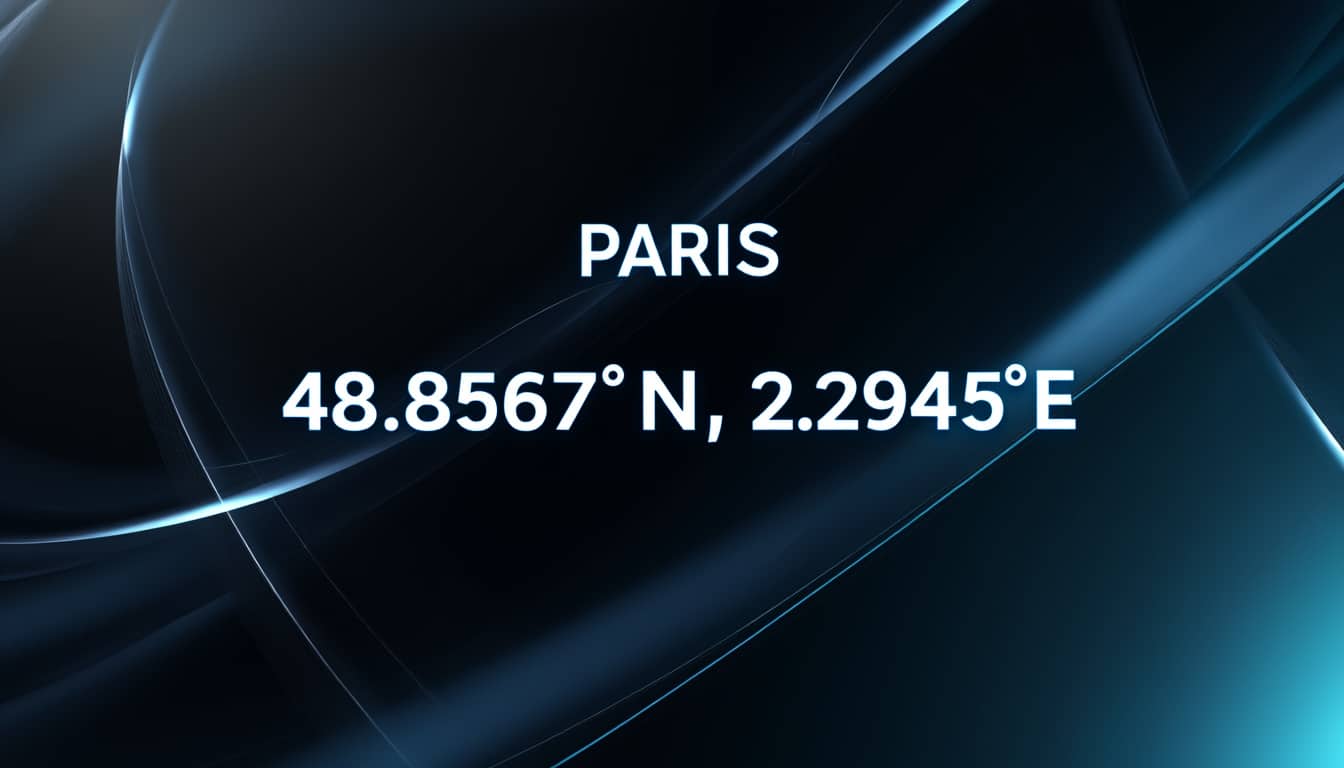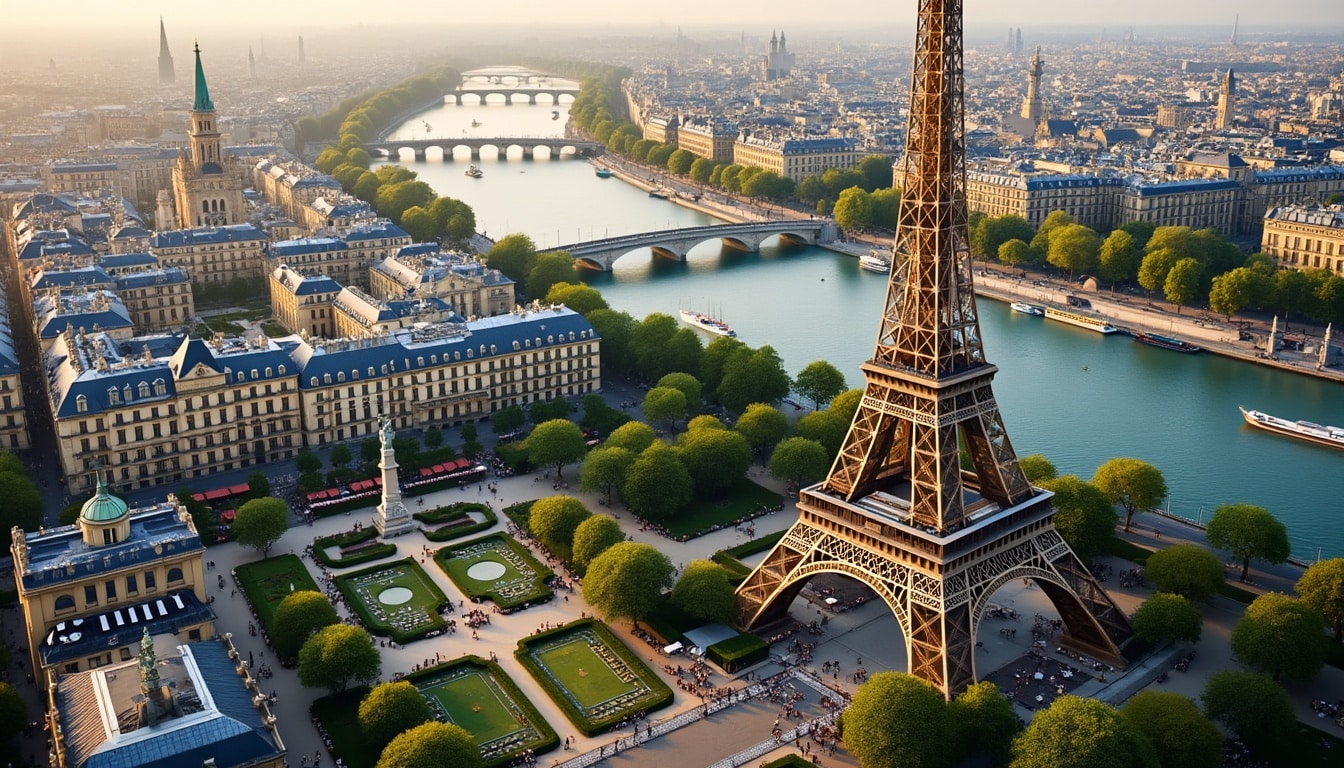Paris, known for its unparalleled beauty and rich history, is a city that captures the imagination of millions around the world. From iconic landmarks like the Eiffel Tower to charming cobbled streets and vibrant art scenes, Paris is a destination that allures people from all corners of the globe. But what truly defines Paris’s allure isn’t just its cultural offerings; it’s also about its geographic positioning. Located in Northern France, Paris sits on the banks of the Seine River and serves as the heart of the Île-de-France region. Whether you’re using Google Maps to find your way through its arrondissements or exploring the city with Citymapper, understanding the location and coordinates of Paris can vastly enhance your travel experience. Let’s delve deeper into the precise geographical elements that make Paris so accessible and captivating.
Understanding the Geographic Coordinates of Paris
Paris is positioned at 48.8566° N latitude and 2.3522° E longitude. These coordinates place Paris firmly in the northern part of France and slightly to the east. But what does this mean for those using technological tools like GPS or apps such as Uber and Lyft? The latitude and longitude provide a precise method of pinpointing Paris on a map, crucial for navigation and exploration in this sprawling metropolis. This region falls under the standard WGS 84 coordinate system, frequently used by Global Positioning System (GPS) devices.
Latitude signifies the distance north or south from the equator. For Paris, being located at 48.8566° North means that it is relatively far from the equator, contributing to its temperate oceanic climate, which has an impact on the daily life and activities within the city. Longitude, on the other hand, determines the distance east or west of the prime meridian. Paris’s 2.3522° East places it just slightly east of the prime meridian, reflecting its position in Western Europe, amidst neighboring countries like Belgium, Germany, and Switzerland.
For tech-savvy travelers and locals alike, these coordinates are invaluable. Whether you’re booking an adventure through sites like Viator or organizing accommodation through Airbnb, understanding these coordinates aids in planning and logistics. Thoughtful navigation aids like Google Maps or Citymapper rely heavily on such geographical data to provide efficient transportation solutions. Moreover, for those intrigued by the finer details, the decimal degrees (DD) and degrees, minutes, seconds (DMS) formats of the coordinates provide different ways to express geographic information.

The centralized position of Paris in the northern hemisphere also supports its status as a global hub for culture, art, and politics. This strategic location not only boosts tourism but also facilitates an exchange of ideas and influences between the city and the rest of the world.
The Significance of Paris’s Location in France
The geographical location of Paris within France contributes significantly to its role as the country’s capital and largest city. Sitting in the Île-de-France region, Paris is connected by a comprehensive network of roads and railways that make it easily accessible from other parts of France and Europe. This accessibility is a key factor in Paris’s sustained prominence as a hub for business, culture, and art.
Seeded on the banks of the Seine River, Paris’s location has historically been vital for trade and transportation. The river enhances the city’s beauty, provides picturesque views, and plays a practical role in its infrastructure. Today, touring companies like TripAdvisor highlight scenic boat tours on the Seine as a quintessential Parisian experience, offering a unique perspective on landmarks such as the Notre-Dame Cathedral and the Louvre Museum.
The physical position of Paris helps define its climate and natural environment, setting it apart from other French cities. The region experiences an oceanic climate, characterized by mild, damp winters and warm, humid summers. This climate has fostered a landscape adorned with lush parks, like the Bois de Boulogne and Luxembourg Gardens, which provide residents and tourists with spaces to unwind and enjoy nature in an urban setting.
Moreover, Paris’s centralized location in Western Europe makes it a gateway to the continent, bridging cultures and facilitating economic growth. Several major European cities, such as London, Brussels, and Frankfurt, are just short flights away, underscoring Paris’s integral role within the European Union. The expansion of high-speed train networks, like the Eurostar and TGV, further enhances this connectivity.
| City | Distance from Paris (km) | Travel Time (by train) | Emoji Representation |
|---|---|---|---|
| London | 344 | 2h 15m | 🇫🇷 ➡️ 🇬🇧 |
| Brussels | 319 | 1h 22m | 🇫🇷 ➡️ 🇧🇪 |
| Frankfurt | 575 | 3h 45m | 🇫🇷 ➡️ 🇩🇪 |
For those considering moving to Paris, understanding the geographic advantages is crucial. From relocating legally to understanding social and legal rules, exploring resources such as Paris Exploration can help newcomers smoothly transition into Parisian life.
Legal and Geographic Implications of Paris’s Position
Paris’s geographic positioning also impacts legal and administrative frameworks. The city is not just a cultural and economic capital but also a political center where key legislative decisions are made. Its geography fosters a unique blend of local and international influences that shape its legal landscape.
One aspect influenced by Paris’s location is its role as an entry point into the Schengen Area. Travelers to Paris benefit from easy access to numerous European destinations without the need for additional visas, a convenience facilitated by the city’s strategic placement. Visitors need to be aware of certain legal parameters, such as drinking age restrictions and holiday openings, which can be accessed through platforms like Paris Exploration.
Paris’s position also dictates specific legal regulations pertaining to transportation. Being centrally located, Paris has implemented extensive laws governing transport services like Uber and Ford rideshare to manage the flow of traffic and maintain its historic appeal. Environmental policies often intersect with transportation regulations, aiming to preserve the city’s heritage while accommodating modern infrastructure needs.
- 🚇 Public transportation is extensively regulated to reduce congestion and pollution.
- 🛴 E-scooters and bike-sharing programs are promoted as eco-friendly alternatives.
- 🚗 Car use limitations in certain neighborhoods ensure pedestrian-friendly spaces.
Moreover, social and legal rules, such as those related to drinking, smoking, and drug use, reflect Paris’s blend of tradition and modernity. The city’s authorities emphasize balancing the vibrant nightlife that attracts tourists and locals with regulations that maintain public order and safety.
For newcomers or tourists, understanding these legal implications can enhance one’s experience in Paris, offering both safety and enjoyment. Resources like communication rules or moving legally portals help expatriates navigate the adjustments necessary for settling in Paris.
Practical Tips for Navigating Paris with Coordinates
Understanding the geographic positioning of Paris is not just an academic exercise; it’s a practical tool for any traveler or resident. Those who navigate the city frequently by car or public transport will find these insights especially useful, whether you’re an Uber driver using precise coordinates to find your destination or a tourist eager to explore hidden treasures.
Leveraging digital tools like Booking.com for accommodations or Viator for tours, travelers can map out their journeys effectively, ensuring no locale is missed. GPS coordinates are a foundational element in these processes, guiding every step of the way.
For newcomers navigating Paris, here are some valuable tips:
- 🗺 Utilize apps like Citymapper for quick transit routes across the city.
- 🚖 Always confirm location details with Uber or Lyft drivers using the exact longitude and latitude.
- 🏨 Use Booking.com to find accommodations that situate you ideally for exploration.
- 🔎 Plan visits to major attractions by cross-referencing their geographic coordinates with your itinerary.
- 🌐 Stay updated with local news on Paris Exploration for insights into changing transport conditions or legal rules.
In conclusion, the coordinates and location of Paris offer more than mere positioning. They serve as a guide, helping locals and visitors alike navigate this breathtaking city. Whether you’re catching an Uber to the Eiffel Tower or exploring the back streets of Montmartre, knowing where you are in relation to the world adds a layer of understanding that transforms your stay into more than just a visit—it’s an experience of a lifetime.
Connecting Paris’s Coordinates with Everyday Experiences
For many, the experience of living, working, or vacationing in Paris is a dream realized. But to truly optimize this experience, understanding how Paris’s coordinates interact with daily life can be transformative. For instance, imagine waking up in an Airbnb nestled within a historic quartier, your day starting with a glance at your coordinates ensuring you’re perfectly positioned to enjoy a vibrant market nearby or a café mere steps away.
The everyday experiences are deeply intertwined with Paris’s geographical location. From an art writer’s perspective, Paris is a masterpiece of human creativity, one that can be appreciated through both its renowned museums and grassroots galleries. A stroll along its streets can reveal hidden murals, while a look at coordinates might guide you to lesser-known art spots cherished by locals.
Engage with platforms like Tripadvisor to discover public events or artistic happenings enhanced by the city’s geography. Moreover, understanding location dynamics can lead to more enriching culinary experiences. With Paris being a gastronomic hub, navigating to specific coordinates can lead you to a quaint bistro or a high-end restaurant offering a taste of French innovation and tradition alike.
.Table:
| Activity | Location (Coordinates) | Nearby Attractions | Emoji |
|---|---|---|---|
| Visit Louvre | 48.8606° N, 2.3376° E | Seine River, Tuileries Garden | 🎨 |
| Explore Montmartre | 48.8867° N, 2.3431° E | Sacré-Cœur, Street Art | 🎭 |
| Cafe at Le Marais | 48.8575° N, 2.3632° E | Jewish Quarter, Vintage Shops | ☕️ |
Ultimately, embracing the geographic foundation of Paris doesn’t just aid in navigation but connects one to the cultural tapestry that defines this remarkable city. From savoring local delicacies to immersing oneself in the art scene, understanding coordinates as part of Paris’s living landscape offers a profound way to engage with all it has to offer.
FAQ Section
- What are the exact GPS coordinates of Paris? – Paris is located at latitude 48.8566° N and longitude 2.3522° E.
- How do geographic coordinates help in navigating Paris? – Coordinates allow for precise navigation and can guide you through detailed city maps and transportation services efficiently.
- Why is Paris’s location important for travelers? – Paris’s central location in Europe makes it easily accessible from many major cities, enhancing travel experiences with a mix of neighboring cultural influences.

When one thinks of Paris, visions of the iconic Eiffel Tower, charming street cafés, and exquisite cuisine might instantly come to mind. Yet, beneath its cultural richness lies a fertile tapestry of landscapes that intricately shape this vibrant metropolis. From…

Geographical features of Paris
Paris, the “City of Light,” is not only known for its iconic landmarks and vibrant culture but also for its remarkable geographical features. From its strategic location on the River Seine to the charming islands within its heart, Paris offers…

Paris, the City of Light, is not just famous for its stunning architecture and exquisite gastronomy; it’s also home to a vibrant mosaic of parks and green spaces. These offer both residents and visitors a chance to escape the urban…


